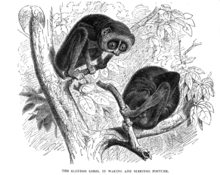Lorisidae
Lorisidae (or sometimes Loridae) is a family of strepsirrhine primates. The lorisids are all slim arboreal animals and comprise the lorises, pottos and angwantibos. Lorisids live in tropical, central Africa as well as in south and southeast Asia.
| Lorisids[1] | |
|---|---|
 | |
| Slender loris (Loris sp.) | |
| Scientific classification | |
| Kingdom: | Animalia |
| Phylum: | Chordata |
| Class: | Mammalia |
| Order: | Primates |
| Suborder: | Strepsirrhini |
| Superfamily: | Lorisoidea |
| Family: | Lorisidae Gray, 1821 |
| Type genus | |
| Loris | |
| Genera | |
| Synonyms | |
| |
Description
Lorisids have a close, woolly fur, which is usually grey or brown, darker on the top side. The eyes are large and face forward. The ears are small and often partially hidden in the fur. The thumbs are opposable and the index finger is short. The second toe of the hind legs has a fine claw for grooming, typical for strepsirrhines. Their tails are short or are missing completely. They grow to a length of 17 to 40 cm and a weight of between 0.3 and 2 kg, depending on the species. Their dental formula is similar to that of lemurs: 2.1.3.32.1.3.3
Behavior
Lorisids are nocturnal and arboreal. Unlike the closely related galagos, lorisids never jump. Some have slow deliberate movements, whilst others can move with some speed across branches. It was previously thought that all lorisids moved slowly, but investigations using red light proved this to be wrong. Nonetheless, even the faster species freeze or move slowly if they hear or see any potential predator. This habit of remaining motionless whilst in danger is successful only because of the leafy environment of their jungle home, which helps to conceal their true position.[3] With their strong hands they clasp at the branches and cannot be removed without significant force. Most lorisids are solitary or live in small family groups.
Slow lorises from southeast Asia produce a secretion from their brachial gland (a scent gland on the upper arm, between the axilla and elbow), that is licked and mixed with their saliva to form a toxin which may be used for defense. The red slender loris (Loris tardigradus) from India also possesses brachial glands, but it is uncertain whether they also synthesize the toxin. The potto (Perodicticus potto) is thought to lack brachial glands, though it produces similar toxic excretions with its anal glands.[4]
Diet
Lorisids consume insects, bird eggs and small vertebrates as well as fruits and gums.[5][6][7][8]
Reproduction
Lorisids have a gestation period of four to six months and give birth to two young. These often clasp themselves to the belly of the mother or wait in nests, while the mother goes to search for food. After three to nine months - depending on the species - they are weaned and are fully mature within 10 to 18 months. The life expectancy of lorises can be to up to 20 years.
Classification
There are five genera and eleven species of lorisid.[1]
- Order Primates
- Suborder Strepsirrhini: non-tarsier prosimians
- Infraorder Lemuriformes
- Superfamily Lemuroidea
- Superfamily Lorisoidea
- Family Lorisidae
- Subfamily Perodicticinae
- Genus Arctocebus
- Calabar angwantibo, Arctocebus calabarensis
- Golden angwantibo, Arctocebus aureus
- Genus Perodicticus
- Potto, Perodicticus potto
- Genus Pseudopotto
- False potto, Pseudopotto martini
- Genus Arctocebus
- Subfamily Lorisinae
- Genus Loris
- Red slender loris, Loris tardigradus
- Gray slender loris, Loris lydekkerianus
- Genus Nycticebus
- Sunda slow loris, Nycticebus coucang
- Javan slow loris, Nycticebus javanicus
- Bengal slow loris, Nycticebus bengalensis
- Pygmy slow loris, Nycticebus pygmaeus
- Philippine slow loris, Nycticebus menagensis
- Bangka slow loris, Nycticebus bancanus
- Bornean slow loris, Nycticebus borneanus
- Kayan River slow loris, Nycticebus kayan
- †? Nycticebus linglom
- Genus Loris
- Subfamily Perodicticinae
- Family Galagidae: galagos
- Family Lorisidae
- Infraorder Lemuriformes
- Suborder Haplorrhini: tarsiers, monkeys and apes
- Suborder Strepsirrhini: non-tarsier prosimians
References
| Wikispecies has information related to Lorisidae |
- Groves, C. P. (2005). Wilson, D. E.; Reeder, D. M. (eds.). Mammal Species of the World: A Taxonomic and Geographic Reference (3rd ed.). Baltimore: Johns Hopkins University Press. pp. 121–123. ISBN 0-801-88221-4. OCLC 62265494.
- Brandon-Jones, D.; Eudey, A. A.; Geissmann, T.; Groves, C. P.; Melnick, D. J.; Morales, J. C.; Shekelle, M.; Stewart, C.-B. (2004). "Asian Primate Classification" (PDF). International Journal of Primatology. 25 (1): 100. doi:10.1023/b:ijop.0000014647.18720.32.
- Charles-Dominique, Pierre (1984). Macdonald, D. (ed.). The Encyclopedia of Mammals. New York: Facts on File. pp. 332–337. ISBN 0-87196-871-1.
- Alterman 1995, pp. 421–423.
- Estes, R. D. (1991). The Behavior Guide to African Mammals. University of California Press. pp. 458. ISBN 978-0520080850.
- Svensson, M.; Nekaris, K.A.I. (2019). "Arctocebus aureus". IUCN Red List of Threatened Species. 2019: e.T2053A17969875. Retrieved 24 December 2019.
- "Slender loris - Introspective World". anintrospectiveworld.blogspot.ca. Retrieved 5 April 2018.
- Streicher, U.; Singh, M.; Timmins, R.J. & Brockelman, W. (2008). "Nycticebus bengalensis". IUCN Red List of Threatened Species. 2008: e.T39758A10263081. doi:10.2305/IUCN.UK.2008.RLTS.T39758A10263081.en. Retrieved 24 December 2019.
Literature cited
- Alterman, L. (1995). "Toxins and toothcombs: potential allospecific chemical defenses in Nycticebus and Perodicticus". In Alterman, L.; Doyle, G.A.; Izard, M.K (eds.). Creatures of the Dark: The Nocturnal Prosimians. New York, New York: Plenum Press. pp. 413–424. ISBN 978-0-306-45183-6. OCLC 33441731.CS1 maint: ref=harv (link)